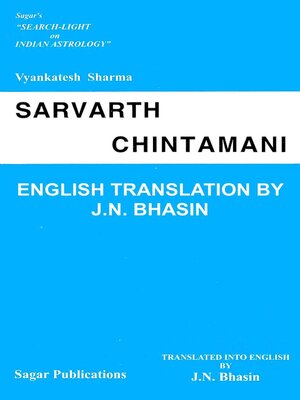
Sign up to save your library
With an OverDrive account, you can save your favorite libraries for at-a-glance information about availability. Find out more about OverDrive accounts.
Find this title in Libby, the library reading app by OverDrive.



Search for a digital library with this title
Title found at these libraries:
| Library Name | Distance |
|---|---|
| Loading... |
Sarvarth Chintamani is one of the top astrological works. From the point of view of practical utility it offers very valuable comments on the subjects relating to
each of the 12 houses of a birth chart. It has the unique distinction of following a procedure where by the main subject or objects pertaining to a house are first of all stated in the very beginning of the chapter relating to that house and then each of those subjects is dealt within a suitable astrological way on the basis of the house concerned, its lord and its significator and the result-good and bad-declared.
>The first house is named as hora, tanu, (body) moorti, (comple-xion) udaya (rising) shir, (head).
>The second is called vaag (speech), vitta (wealth), kutumba (family) eye.
>The 3rd is called sahotha (brother), dushchikya. gala (throat).
>The 4th is called shourya (bravery), karna (ears), sukha, water, bandhu (comforts, nater & friend & relatives) rasatal (nadir) hibuk (chest) veshma (residence), patal (nadir) hrid (heart), vahan (conveyance), matri (mother).
>The 5th is called budhi (intellect), prabhav (influence), aatmaj (son), mantra (advisory capacity), vivek (discrimination), udar (belly).
>The 6th is called disease, kshat (injury), ari (enemies), vysanam (addiction), chor (theft), vighana (obstacles).
>The 7th is called chittoth, kaam, madan (sexual urge), wife, bhrtri (husband), dadih, (curd) soup.
>The 8th is called ksheer (milk), gudam (gur) montra kricha (urinary trouble), goohya (hidden), randhra (bad) marana anta (death), Aayou (age).
>The 9th is termed as dharma (duty), daya (compassion), paitrik (father), bhagya (luck), guru (preceptor), tapas (penance), laabh (gains), shubhaarjitaani (earned merit).
>The 10th is termed as aagya (orders), maan (honour), dashma (tenth), karma (actions), aspad (position), kham (sky).
>The 11th is termed as ayam & laabh (gains).
>The 12th is termed as vyaya (expenditure), antya (last sign), rishpha (bad), vinash (destruction).
"A question may be raised as to why a particular Planet gets exalted in a particular sign & degree. So far as we are aware no author has answered this question. We, however, think that this can be explained on the basis of spirituality to which astrology owes allegience being its main limb. The 10th degree of Aries falls in the asterism Ashvini whose lord is Ketu. Ketu has been declared by astrology as the "Moksha" karka i.e. the significator for salva-tion. The Sun is very well krown as the "Atma" in the Vedas."
"Since the shadowy planets Rahu and Ketu easily take upon themselves the influence of other planets etc. we have deduced a corollary from the above rule that in throwing their own malefic influence on the house these shadowy planets may be aspecting, they will also throw on the aspected houses the malefic influence of the malefic planet or planets that may be influencing these nodes, by association or aspect"
Excerpts From
Sarvarth Chintamani
J.N. Bhasin







